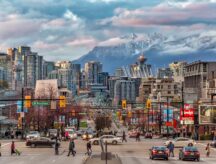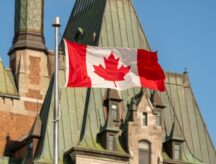Ontario and Quebec premiers deny systemic racism in Canada, immigration history says otherwise
Two Canadian premiers openly denied systemic racism in Canada the same week that Black Lives Matter demonstrations cropped up around the world.
The discussion of systemic racism has exploded following the death of George Floyd, a Black man who was killed after being restrained by a white police officer in the U.S.
Ontario and Quebec’s premiers faced public backlash for their comments suggesting that Canada does not have a systemic racism problem like the U.S. Between the two of them, only Ontario’s premier, Doug Ford, retracted his statement. Speakers at an anti-racism demonstration in Quebec criticized Premier Francois Legault for downplaying the problem.
Find out if you are eligible for any Canadian immigration programs
The premiers' comments reflect a misconception that runs through the veins of Canadian society. Canadians have a history of presenting themselves as "less racist" than the U.S., but systemic racism is as old as Canada itself.
The country was established by French and British nationals who colonized what many Indigenous groups called Turtle Island, now known as North America. After Canada became recognized as a nation by British standards in 1867, nearly 100 years of discriminatory immigration selection would follow. The type of discrimination would reflect the zeitgeist of the white, Christian inhabitants and the government in power at the time.
Though the shift to a points-based system in 1967 is often cited as the point where discriminatory policies in Canadian immigration selection were retired, momentum actually began in 1962 under immigration minister Ellen Fairclough.
“The Immigration Act and Regulations [prior to 1962] provided grounds of refusal on the basis of nationality, race and the inability of certain people from certain social backgrounds to establish themselves successfully in Canada,” said Robert Vineberg, retired senior public servant and Canadian immigration historian who wrote a chapter on Fairclough in the book, Reassessing the Rogue Tory: Canadian Foreign Relations in the Diefenbaker Era.
“It was a very discriminatory system.”
Canadian immigration without a points-based system
Canadian immigration between 1867 and 1962 encouraged western colonization by pandering to old commonwealth countries and the U.S. This resulted in various ethnic groups being explicitly excluded, and furthered the genocide of Indigenous people.
So-called “Asiatic” countries were often the targets of restrictions. Chinese people were banned between 1923 and 1947, and before that they were the only ethnic group to be required to pay a “head tax” for entry to Canada. In 1911, an Order-in-Council was put forward to stop the immigration of Black people who were deemed “unsuitable for climate and requirements of Canada.” The instructions were for immigration inspectors and medical aids to stop Black people from entering Canada based on “medical” grounds.
These are not the only discriminatory bans put in place. Immigration policies during World War I and World War II imposed disproportionate regulations against nationals of “enemy” countries. During the Second World War, political refugees from Germany were often unable to navigate Canadian immigration policies, and consequently turned away.
Social change began stirring in postwar times. The economy was seeing an upturn and Canada sought labour, specifically from European countries, to help support economic growth.
A number of external and internal pressures went into play. Immigrants and their children within Canada were calling for the end of racial and ethnic discrimination against them.
Canada was also starting to look hypocritical within the British Commonwealth for opposing apartheid in South Africa, while still upholding “White Canada” immigration policies.
Find out if you are eligible for any Canadian immigration programs
The start of change
Ellen Fairclough was the first woman ever appointed to the Canadian Cabinet in 1957 after seven years in the House of Commons. She became the immigration minister the following year under former Prime Minister John Diefenbaker. Vineberg described her as an advocate for eliminating discrimination during her time in Parliament.
The 1962 changes to immigration policy meant that Canada would admit immigrants based on their merit. As Ellen Fairclough said, anyone could be considered for Canadian immigration, “without regard to his race, colour, national origin, or the country from which he comes.”
“Basically the beginning of a nondiscriminatory immigration policy, and one that assessed people on their own qualifications, began in 1962,” Vineberg said. However, this new system was criticized for lacking objectivity in assessing credentials of merit. “Then in 1967 it was expanded on the use of the points system to try to, as much as possible, eliminate bias.”
The Diefenbaker government had been defeated by the Liberals in 1963. However, the new Liberal government wished to continue reforming the system and make it more responsive to labour market needs.
In 1966, the Immigration Service was merged into the new Department of Manpower and Immigration and the government published a white paper recommending that Canada assess immigrant eligibility criteria more objectively.
“Within the department of immigration they were looking for a way to implement a more objective selection system and they brought in the senior officers from around the world to help develop a proposal, which was in fact the points system,” Vineberg said.
Canada became the first country in the world to adopt a points-based immigration system in 1967. Since then, many other countries have developed similar systems for immigration assessment.
By 1971, the majority of immigrants to Canada were of non-European ancestry. Today, Canada welcomes immigrants from about 175 countries each year. The majority of Canadian immigrants come from India, followed by China, the Philippines, Nigeria, and the U.S.
Not the end
Supporting anti-racism in immigration policy does not stop with having diverse applicants, immigration policy analyst Georgette Morris, told CIC News.
“Any sovereign nation has the ability to decide how they want to make their immigration policies,” Morris said. “Keeping that in mind, the question becomes, ‘what do we value as a society, as a country, and what do immigration departments value?’ And that will inherently have certain outcomes.”
Though the points system aims to take discrimination out of immigrant selection, the applicant’s credentials are assessed on a scale built by the Canadian government. Human capital factors are weighted based on what the government decides is required for successful integration into the Canadian labour market. From this standpoint, the points system cannot be considered objective.
Points-based systems that give preference to highly-skilled labour have been criticized for perpetuating global labour inequalities, including those that disproportionately affect women, and people from countries without the infrastructure that allows immigration candidates to meet the education and work experience requirements.
Discrimination in Canada's points-based immigration system today can be seen in the facilitated pathways to permanent residence for high-skilled labour, even though so-called unskilled, or low-skilled labour is also in demand, and also supports the economy. For example, the tech industry has multiple avenues for foreign talent to gain permanent residence, while the agriculture and agri-food sectors are still in need of more support even though the Agri-Food Immigration Pilot program was just recently launched.
Find out if you are eligible for any Canadian immigration programs
© 2020 CIC News All Rights Reserved
- Do you need Canadian immigration assistance? Contact the Contact Cohen Immigration Law firm by completing our form
- Send us your feedback or your non-legal assistance questions by emailing us at media@canadavisa.com







